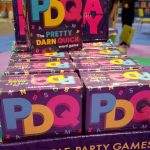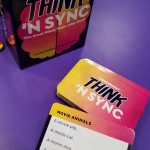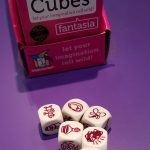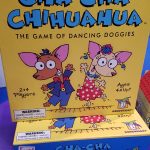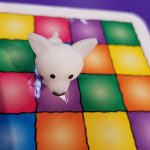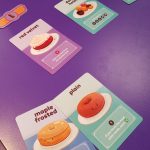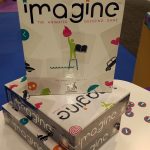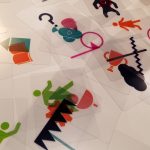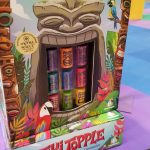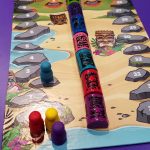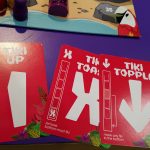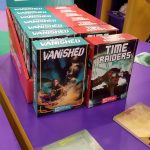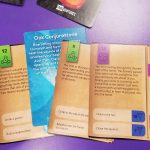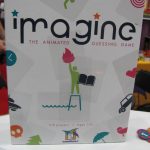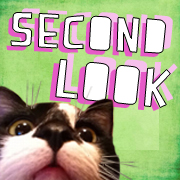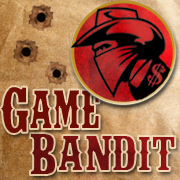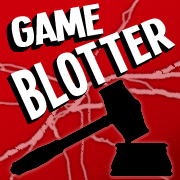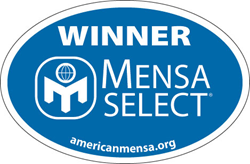 At the Mensa Mind Games this past weekend in the Virginia suburbs outside Washington, DC, member judges played through and selected the following games as 2017 Mensa Select winners:
At the Mensa Mind Games this past weekend in the Virginia suburbs outside Washington, DC, member judges played through and selected the following games as 2017 Mensa Select winners:
Amalgam from Simply Fun—A game in which the players, as wizards, try to collect sets of potion ingredients but have to rely on their memories of the ingredients they’ve already collected.
Around the World in 80 Days from Iello Games—A Spiel des Jahres winner from years ago (Hare & Tortoise), reproduced based on the Jules Verne novel. Players race around the board, moving forward and back as they wish. However, they must carefully plan to arrive back in London with the least amount of cash left in hand.
Clank! from Renegade Game Studio—A dungeon delve fantasy adventure game built on deck-building mechanisms.
Harry Potter Hogwarts Battle from USAopoly—Another deck-building game, this one follows the novels with a series of cooperative games that get more complex and more difficult to beat as they progress.
Imagine from Gamewright—A party game where the giver-of-clues chooses an item from a card and then tries to illustrate the item by combining images and symbols with an overlay of transparent cards.
- Comments Off on 2017 Mensa Select Winners
 One of of the larger booths I visited at Toy Fair was Gamewright. Several small games were on display as were some games that are about to return to your game store’s shelves.
One of of the larger booths I visited at Toy Fair was Gamewright. Several small games were on display as were some games that are about to return to your game store’s shelves.
In the Port-A-Party line of small games, they had Think ‘n Sync and PDQ, both available in March for $10. PDQ, which we’ve discussed before, has been out of print for five years and returns in a box sized to fit in the Port-A-Party line. In that game, three letter cards are placed in a row and players race to create a word using those letters either left-to-right or right-to-left. Think ‘n Sync is a game that reminded me a bit of Family Feud, except everyone shouts out their answer. Matches gain points.
Rory’s Story Cubes, Fantasia edition, is on its way for a summer release ($8). Fantasia contains three Enchanted dice, three Myth dice, and three Medieval dice.
Cha-Cha Chiahuahua (summer, $16) comes with a bunch of little doggie figures and several disco dance floors for kids 4 and up. Do activities and place your dancing pups on the color-coded dance floor.
Go Nuts for Donuts (summer, $15) is a Sushi Go-like game with bidding instead of drafting. Donut cards are laid out and you select which one to add to your collection; if others are also going for your choice, you all lose out. Each type of donut has different abilities, such as a point reward for having the fewest cards, ability to steal donuts from the discard pile, or a significant number of points for having a large collection of one type.
Imagine (now, $15) is charades with clear cards. Transparent cards with symbols printed on them are layered atop one another to create images others have to guess. A clever way to use see-through cards. Can you tell what’s on the center of the box above?
Tiki Topple (summer, $20) is a reprint of a ten year old game. This new Mensa Select edition has players trying to assemble a totem pole with certain tiki heads nearest the top. Cards that reorder and remove some sections of the pole are used to move your sections up and opponents’ down. But can you tell which tiki heads your opponents are trying to get to the top? It’s a quick game that I really enjoyed playing a demo of — it reminded me a bit of Abandon Ship, but with simpler and shorter gameplay.
This summer, two new entries into the CardVentures line, Vanished and Time Raiders (each $10), will be released. These choose-your-own-adventure-like games join last year’s Stowaway 52 and Jump Ship!. The single-player game is played with oversized cards with story elements, allowing you to jump to additional cards based on your choices to tell a story.
- Comments Off on Toy Fair 2017—Gamewright
 I noticed more family game companies showing up at Gen Con. Gamewright was one of those that hadn’t had a presence in several years. This time, though, the company was right in the Family Fun Pavilion with a debut of Imagine ($15, now). It’s a party game where the giver-of-clues chooses an item from a card and then tries to illustrate the item by combining images and symbols with an overlay of transparent cards. Besides the clue-giver’s artistic abilities, helping the rest around the table to guess the item is at least they know a category.
I noticed more family game companies showing up at Gen Con. Gamewright was one of those that hadn’t had a presence in several years. This time, though, the company was right in the Family Fun Pavilion with a debut of Imagine ($15, now). It’s a party game where the giver-of-clues chooses an item from a card and then tries to illustrate the item by combining images and symbols with an overlay of transparent cards. Besides the clue-giver’s artistic abilities, helping the rest around the table to guess the item is at least they know a category.
- Comments Off on Gen Con 2016—Imagine from Gamewright
Trending
- Massdrop.com
- Oh the Irony—Illuminati Card Game Continues to Inspire Conspiracy Theorists
- Footprints, an Educational Ecology Game
- Home
- USPS Adds Board Game Flat Rate Box
- Baila, the Estonian Drinking Card Game
- Crystal Caste Wins Dice Patent Suit Against Hasbro
- Mirror Game, Red and Blue
- Are Board Games Dangerous?
- Board Games Based on Hindu Mythology
Archives
Most Popular Articles
- Oh the Irony—Illuminati Card Game Continues to Inspire Conspiracy Theorists
- The 20 Most Valuable Vintage Board Games
- The Truth About Dominoes On Sunday in Alabama
- Sequence Game, and Variants
- USPS Adds Board Game Flat Rate Box
- Baila, the Estonian Drinking Card Game
- The 13 Most Popular Dice Games
- Are Board Games Dangerous?
- Guess Who? The Naked Version
- What Happened to the Jewel Royale Chess Set?
Recent Posts
- Toy Fair 2019—Breaking Games
- Talisman Kingdom Hearts Edition
- Toy Fair 2019—Winning Moves
- Toy Fair 2019—Games Workshop
- Toy Fair 2019—Star Wars Lightsaber Academy
- Toy Fair 2019—Stranger Things Games
- Toy Fair 2019—HABA
- Licensing Roundup
- Game Bandit
- 2018 A Difficult Year For Hasbro But Not For D&D Or MtG
Recent Comments
- on Toy Fair 2019—Winning Moves
- on Game Bandit
- on Second Look—Dungeons & Dragons Waterdeep Dragon Heist
- on Crowdfunding Highlights
- on Beyblade SlingShock
- on Game Bandit
- on Game Bandit
- on Watch This Game!, the Board Game Review Board Game
- on Second Look—Vampire: The Masquerade 5th Edition
- on Palladium Books Loses Robotech IP License, Cancels Five-Year-Overdue Robotech RPG Tactics Kickstarter

